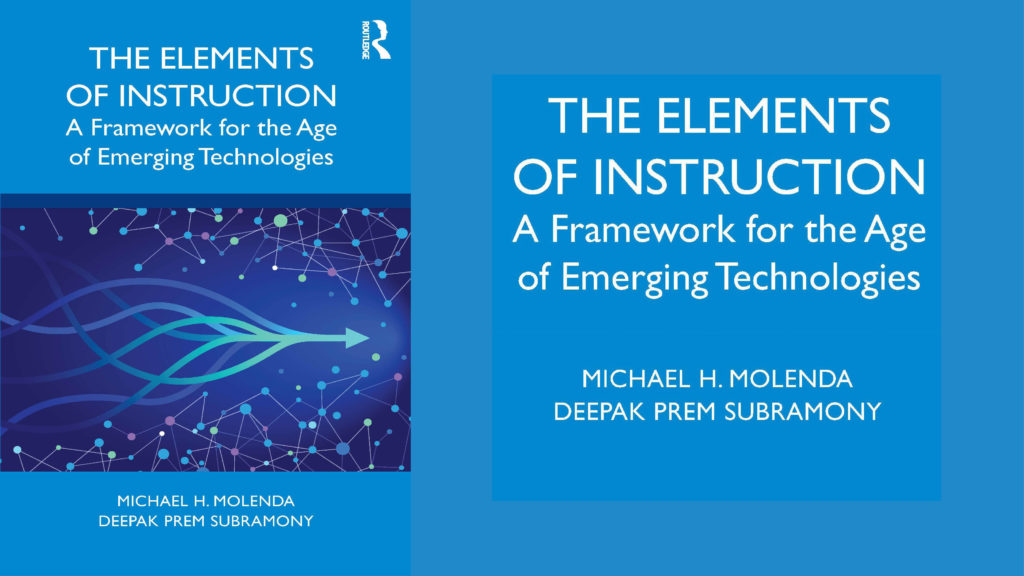The Elements of Instruction is now available! It came off the presses of Routledge on October 25, 2020. Hardcover, softcover, and eBook versions are now available from Routledge and your favorite bookseller. See “The Book” tab above to learn more about the contents of the book and why it was written.
Archives
bookmark_borderMolenda and Subramony are presenting at the AECT 2020 convention
AECT Sessions related to The Elements of Instruction:
- Monday, November 2, 12:00-12-45 p.m. Book Sharing panel. Molenda and Subramony introduce the highlights of The Elements of Instruction.
- Wednesday, November 4, 10:30-11:45 a.m. Making Learning Engaging roundtable. Molenda and Subramony present “A New Typology of Communication Configurations: Building Blocks for Lesson Design”—from Chapters 4-11 of The Elements of Instruction.
- Saturday, November 7, 10:30-11:45 a.m. Molenda and Subramony present “A Framework for Understanding the Role of Sociocultural Factors in Instructed Learning,” drawn largely from Chapter 2 of The Elements of Instruction.
These sessions are being recorded, and they will quickly be made available to those attending the virtual convention.
bookmark_borderSocial and Emotional Learning (SEL)
The general philosophical perspective that schools are for social development as well as academic instruction has been shared by many thinkers throughout history, but today’s version of “social and emotional learning” (SEL) is perhaps most foreshadowed in the work of John Dewey and other progressive social reformers of the early 20th century. Despite their best efforts, American public schools generally proceeded in a more technocratic, achievement-test driven direction.
Nevertheless, concepts that were later incorporated into the SEL movement—such as Kurt Lewin’s notion of the interdependence of person and environment, Bandura’s social learning theory, cognitive behavioral therapy, and affective education—as later reflected in the Martin & Reigeluth chapter in Green Book II (Reigeluth 1999)—were percolating between the 1920s and 1990s.
- Working Paper on SEL by Molenda
- SEL Appendix A: Emotional Intelligence and SEL
- SEL Appendix B: School Environment
- SEL Appendix C: Conceptual Framework for SEL
- SEL Appendix D: Moral Education
Check the detailed documents, and leave your comments below.
bookmark_border“The Elements of Instruction” is at the printers.
The focus of our work for the past three years, “The Elements of Instruction: A New Framework for an Era of Emerging Technologies,” is being published by Taylor & Francis, an imprint of Routledge Publishing.
Our aim is to provide a common vocabulary and conceptual schema of teaching and learning that is fully applicable to all forms of instruction in our digital-centric era. This critical examination of the constructs bandied about in the educational technology literature fills a major gap in the logical foundations of instructional theory and instructional design.
The book proposes a new verbal-visual framework for organizing research and theory, plus clear concepts and definitions for its basic elements.
The authors propose a new typology of teaching-learning arrangements to simplify the selection of optimal conditions for a variety of learning goals.
As trends in media, technology, and methodology continue to evolve, these historically contextual, back-to-basics pedagogical tools will be invaluable to all instructional designers and educational researchers.
It is expected to be available in November 2020. Can be pre-ordered now at:
https://www.routledge.com/The-Elements-of-Instruction-A-Framework-for-the-Age-of-Emerging-Technologies/Molenda-Subramony/p/book/9781138721074.



